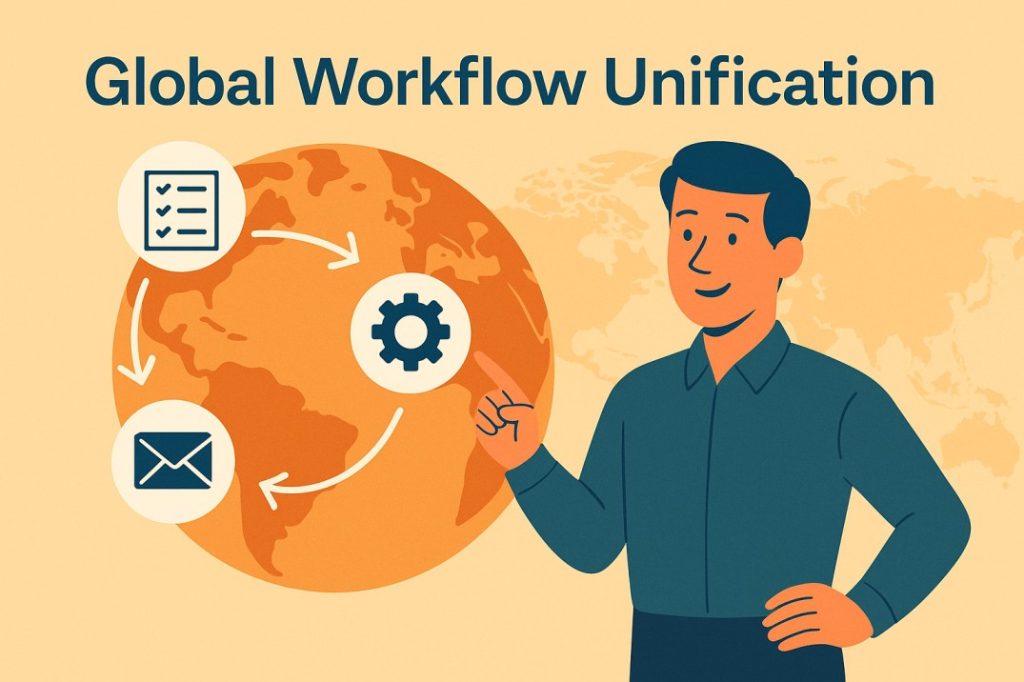Global enterprises today are more connected—and more fragmented—than ever before. Distributed teams span continents, systems multiply through acquisitions, and every department seems to have its own favourite platform.
The result is a paradox: while technology was meant to simplify work, it has instead created a maze of disconnected workflows, duplicated data, and endless meetings to “sync up.”
The next phase of enterprise transformation isn’t just about automation—it’s about orchestration: connecting people, processes, and systems into a single, intelligent workflow ecosystem.
The Fragmentation Problem
In large organisations, fragmentation creeps in slowly:
- Sales works in a CRM, operations uses an FSM, finance relies on ERP.
- Regional offices maintain their own spreadsheets “for accuracy.”
- Teams in Sydney, Singapore, and London spend hours each week reconciling the same data.
According to Deloitte, enterprises lose up to 20% of productivity due to inefficient workflow fragmentation. The cost isn’t just financial—it’s strategic. Decisions slow down, opportunities slip, and teams burn out chasing clarity.
Why Traditional Integration Falls Short
Many enterprises have tried to solve this problem by integrating systems with point-to-point connections or manual data imports. But as systems grow, these solutions become brittle.
Legacy integrations:
- Break when software updates roll out.
- Don’t scale across global time zones or departments.
- Can’t handle process logic like approvals, notifications, and exceptions.
What’s needed now isn’t just integration—it’s workflow unification.
Workflow Unification: The Next Enterprise Advantage
1. Centralised Process Visibility
Modern workflow platforms provide a single pane of glass for enterprise operations. Whether it’s sales quotes, project tasks, or customer escalations, all teams see the same real-time status.
2. Intelligent Orchestration
AI-driven workflow orchestration tools automatically route tasks, trigger actions, and ensure data consistency across systems. This eliminates manual handovers and the “who’s doing what” confusion.
3. Regional Flexibility with Global Consistency
Enterprises can standardise processes (e.g. approvals, service requests) while allowing regional customisation for compliance or cultural differences.
4. Integration via APIs, Not Emails
Rather than emailing spreadsheets, APIs connect CRM, ERP, and communication tools—creating frictionless data flow across departments and geographies.
5. Automation-Enabled Collaboration
Workflow automation tools connect people and systems simultaneously. Approvals, customer updates, and reporting happen automatically, letting teams focus on strategic initiatives instead of administrative tasks.
Case Example: Unifying a Global Services Network
A global professional services enterprise with offices in 12 countries struggled with disjointed project management. Local teams used separate tools for client onboarding, finance, and delivery, leading to inconsistent reporting and billing delays.
By deploying a unified workflow ecosystem integrating CRM, finance, and project systems:
- Data entered once was available enterprise-wide.
- Projects were auto-assigned and tracked by region.
- Billing and compliance reports generated instantly.
The impact: 30% faster project turnaround, improved client satisfaction, and a significant reduction in administrative costs.
Designing the Future of Workflows
The enterprises that thrive in the next decade will master workflow orchestration across:
- People: Connecting global teams through shared visibility and accountability.
- Processes: Standardising core functions while enabling flexibility where needed.
- Platforms: Creating integrated ecosystems, not standalone applications.
The goal isn’t just efficiency—it’s enterprise harmony, where teams move in sync regardless of geography or department.
The Bottom Line
In a global enterprise, complexity is inevitable—but chaos isn’t. By investing in unified, automated workflows, enterprises can connect teams, reduce redundancy, and accelerate performance.
The future of work isn’t about more tools. It’s about smarter, connected workflows that bring global teams together without adding complexity.

